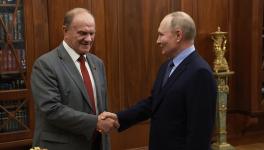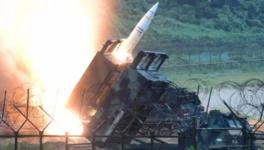US Still Dominates Global Arms Market in 2010
The United States consolidated its domination of a shrinking global arms market in 2010, signing 21.3 billion dollars in new weapons orders with foreign countries, according to the latest edition of an annual report on conventional weapons transfers by the Congressional Research Service (CRS).
Washington's total actually marked a slight decline in orders from 2009. But, because total global arms sales last year fell sharply – nearly 40 percent – from their 2009 level of 65 billion dollars, the US market share rose steeply, from 35 percent in 2009 to nearly 53 percent in 2010.
The US also ranked first in the value of actual arms deliveries in 2010, supplying foreign clients with some 12 billion dollars worth of weapons, or more than a third of the 35 billion dollars in global arms deliveries last year, according to the report. It was the eighth year in a row that Washington led the world in global arms deliveries.
As in previous years, developing countries were the biggest buyers on the international arms market in 2010, accounting for 76 percent of all new arms agreements and nearly 63 percent of actual deliveries, according to the 75-page report, "Conventional Arms Transfers to Developing Nations, 2003-2010."
Among developing countries, India topped the list of buyers, concluding nearly six billion dollars in new deals. It was followed by Taiwan (2.7 billion dollars) and Saudi Arabia (2.2 billion dollars).
India also topped the list as the leading recipient of arms deliveries, having obtained 3.6 billion dollars worth of weapons systems. It was followed by Saudi Arabia and Pakistan which both received 2.2 billion dollars worth of arms shipments, according to the report.
For the entire 2003-2010 period, however, the report found that Saudi Arabia was the developing world's top recipient of arms shipments by far, having received some 29 billion dollars worth of weapons, followed by India, at nearly 17 billion dollars; China (13.2 billion dollars); Egypt (12.1 billion dollars), and Israel (10.3 billion dollars).
The report, which is prepared each year by CRS's top arms expert, Richard Grimmett, is widely considered to be one of the most authoritative on the conventional arms trade because it is based on classified information as well as public data, and its methodology has remained consistent for three decades. Its statistics include both military sales and assistance.
As in previous reports, the latest edition distinguishes between arms agreements that were signed during the previous year and actual arms deliveries. Actual deliveries often fall short of what agreements may originally have called for.
The latest report comes as defence budgets in most developed countries, especially in Europe, are undergoing substantial cuts in reaction to the ongoing financial crisis. Even the Pentagon, whose budget nearly doubled over the past decade, faces the prospect of little or no growth in real terms over the next 10 years.
As a result, major US and European defence contractors are looking to boost sales in foreign markets, particularly in the wealthy markets of Near Eastern oil producers, such as Saudi Arabia and the United Arab Emirates, India, South Korea and Southeast Asia.
"As new arms sales have become more difficult to conclude since the global recession began, competition among sellers has become increasingly intense," according to the report, which noted that arms suppliers have resorted to offering potential clients new incentives, including more flexible financing options and co-production agreements.
Moreover, because of persistent high unemployment rates in the major Western exporters, including the US, the main motivation for selling weapons to foreign clients "may be based as much, if not more, on economic considerations as those of foreign or national security policy", according to Grimmett.
The value of all arms agreements with developing countries came to 30.7 billion dollars in 2010, a major decrease from the nearly 50 billion dollars in deals signed in 2009 and the lowest total since 2003. The nearly 22 billion dollars worth of arms actually delivered to developing countries last year, on the other hand, was the highest since 2006.
The US accounted for 49 percent of all new weapons orders from developing countries last year – a major increase from its 31-percent share in 2009. It was followed by Russia, which maintained its 25- percent share of the developing-country market in 2010; and by the major Western European arms manufacturers, led by Italy, France, and Britain, which held a 13-percent share last year, down from 24 percent in 2009.
The US and Russia have together been the dominant arms sellers to developing countries over the past eight years, according to the report, which noted that Moscow actually beat out Washington in the value of arms agreements it signed in the period 2003-2006, only to be overtaken by Washington in the period 2007-2010.
In actual arms deliveries to developing countries, however, Washington has dominated the past eight years, with about 60 billion dollars worth of transfers, compared to Russia's 38 billion dollars. Britain (19 billion dollars), France (12.3 billion dollars), China (11.6 billion dollars), Germany (6.2 billion dollars), and Israel (3.5 billion dollars) were the other top suppliers.
The US increased its share of the lucrative Near Eastern market dramatically during the eight-year period – from 33 percent of the total value of weapons orders in 2003-2006, to 57 percent in 2007-10.
The Asian market, on the other hand, was far more competitive. It increased its market share from 17 percent to 26 percent in the two periods. Fuelled by deals with India, on the other hand, Russia captured 36 percent of the market in the first period and 30 percent in the second. The major European lost most over the eight years, from 23 percent of the market's value to 15 percent, according to the report.
Over the same eight-year period, Saudi Arabia was the top buyer, signing 44.3 billion dollars in new arms deals, followed by India (38.1 billion dollars), the UAE (18.7 billion dollars), Egypt (14.4 billion dollars), Pakistan (13 billion dollars), Venezuela (12.7 billion dollars), South Korea (10 billion dollars), and Brazil (9.8 billion dollars). Saudi Arabia last year agreed in principle to buy some 60 billion dollars in US-manufactured aircraft in the coming years.
As for actual arms deliveries since 2003, Saudi Arabia again topped the list, receiving some 29 billion dollars' worth of weapons. It was followed by India (16.9 billion dollars), China (13.2 billion dollars), Egypt (12.1 billion dollars), Israel (10.3 billion dollars), UAE (8.6 billion dollars), Taiwan (8.3 billion dollars), and Pakistan (7.6 billion dollars).
Jim Lobe's blog on US foreign policy can be read at http://www.lobelog.com.
Get the latest reports & analysis with people's perspective on Protests, movements & deep analytical videos, discussions of the current affairs in your Telegram app. Subscribe to NewsClick's Telegram channel & get Real-Time updates on stories, as they get published on our website.
























